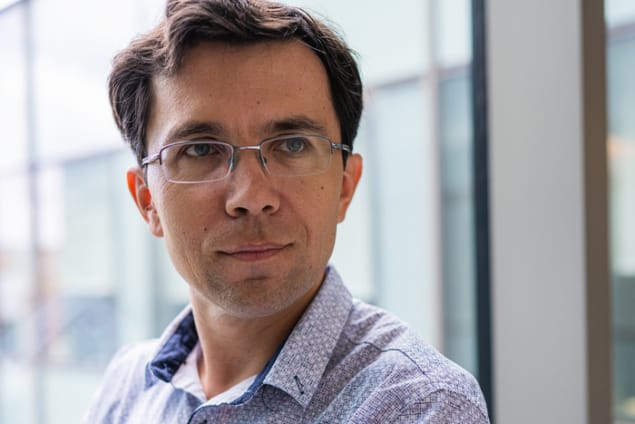
For decades, quantum spin liquids were seen as largely hypothetical, with real-world examples thought to exist only in unusual systems such as quasi-one-dimensional chain-like magnets and a handful of two-dimensional materials. Then, in 2019, researchers at Rice University in the US and McMaster University in Canada found experimental evidence that a pyrochlore magnet, Ce2Zr2O7, could be a long-sought-after example of a three-dimensional quantum spin liquid (3D QSL). This “experimental conjecture” has now received further support from physicists at Rice and Florida State University in the US. Working with colleagues at the Max Planck Institute for Physics of Complex Systems in Dresden, Germany, the researchers used a combination of theoretical techniques to conclude that Ce2Zr2O7 (CZO for short) is indeed a 3D QSL.
QSLs form when atoms in solid magnetic materials cannot arrange their magnetic moments (or spins) into a regular and stable pattern. This “frustrated” behaviour is very different from that of ordinary ferromagnets or antiferromagnets, which have spins that point in the same or alternating directions, respectively.
Quantum mechanics explains this frustration by suggesting that the orientation of the spins is not rigid. Instead, the spins constantly change direction in a fluid-like way, producing an entangled ensemble of spin-ups and spin-downs. Thanks to this behaviour, a QSL will remain in a liquid state even at temperatures near absolute zero, where most materials freeze solid.
“Sleuthing out” the parameters of a theoretical model
In 2019, two experimental groups – one led by Pengcheng Dai at Rice and the other by Bruce Gaulin at McMaster – concluded, based on data from thermodynamic and neutron scattering experiments, that CZO behaved in a way consistent with a 3D QSL. In the latest work, a team led by Florida State’s Hitesh Changlani set out to prove its status beyond reasonable doubt.
To do this, Changlani and colleagues analysed the raw data from both experiments, seeking to determine the optimal parameters of a so-called dipole-octupole model of cerium magnetic moments with strong spin-orbit coupling. Finding these parameters would establish what kind of QSL exists in CZO – if indeed one exists at all.
“This was a daunting task and the simple ‘mean-field’ treatment we initially attempted did not work,” Changlani says. In its place, the team turned to an alternative known as the finite temperature Lanczos method, together with a classical–quantum correspondence previously developed by some of the team’s members, to perform quantum calculations of the material’s specific heat and magnetization.
This approach allowed the researchers to model the material’s molecular spin dynamics (based on the Landau-Lifshitz equation) and compare their results with those from the earlier inelastic neutron scattering experiments. According to the team, the modelled parameters “capture[d] the salient features of the experimental data both qualitatively and quantitatively”.
“Upon taking into account all the experimental data on CZO and previous theoretical proposals for QSLs on the pyrochlores, we were able to ‘sleuth out’ the parameters of the theoretical model that could indeed describe all the observations,” Changlani explains, adding that the model was first proposed in a paper in Physical Review Letters in 2014. “From everything we know, it would appear that the 2019 experimental conjecture was correct.”
“Worth looking at more closely”
Until now, many quantum materials researchers thought that for a material to have exhibit strong quantum fluctuations, and hence a predisposition towards QSL behaviour, it needed to have reduced dimensionality – that is, its structure needed to consist of weakly coupled planes that could be thought of as 2D-like. “Our work challenges this notion,” Changlani tells Physics World. “We have provided evidence that 3D pyrochlores are an example of frustrated magnets worth looking at more closely.”
In terms of practical applications, Changlani says it is too early to say what they might be. Although some versions of quantum computing are based on the use of fractionalized excitations realized in QSLs, he cautions that “we do not know yet whether CZO could fit the bill here”.
According to team member Andriy Nevidomskyy, the results are more exciting for fundamental physics – including a possible connection between QSLs and magnetic monopoles, which are hypothetical particles that carry an isolated north or south magnetic pole.

Promising quantum spin liquid candidate may fall short
“Of course, in classical physics one can never isolate just one end of a bar magnet,” he says. “The north and south monopoles always come in pairs. But in quantum physics, magnetic monopoles can hypothetically exist, and quantum theorists constructed these almost 100 years ago to explore fundamental questions about quantum mechanics.
“As far as we know, magnetic monopoles don’t exist in a raw form in our universe,” Nevidomskyy continues. “But it turns out that a fancy version of monopoles does exist in these cerium pyrochlore quantum spin liquids. A single spin flip creates two fractionalized quasiparticles called spinons (particles that would carry an electron’s spin) that behave like monopoles and wander around the crystal lattice.”
The researchers say they also found evidence that monopole-like spinons were “created in an unusual way” in CZO. Due to the material’s tetrahedral arrangement of magnetic atoms, it might develop octupolar magnetic moments – that is, spin-like magnetic quasiparticles with eight poles — at low temperatures. “Our research showed spinons in the material were produced from both these octupolar sources and more conventional, dipolar spin moments,” Nevidomskyy concludes.
Full details of the research are reported in npj Quantum Materials.
